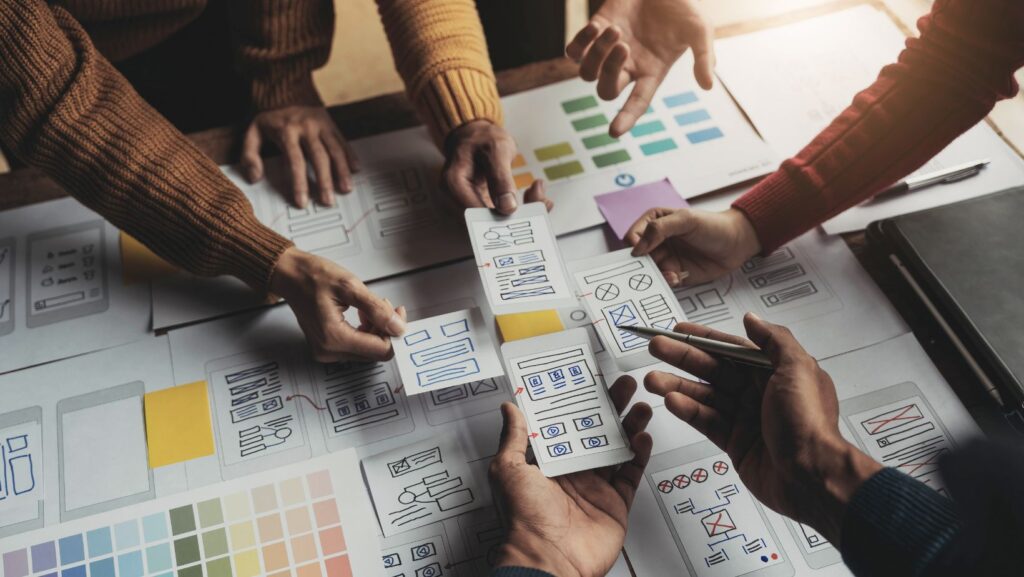You may have come across the term “UX” and wondered what it’s all about.
Well, let me break it down for you.
UX stands for User Experience.
At MOCK, the Agency, we believe that user experiences are essential.
What is user experience?
This is a big area a designer can work in, that focuses on creating meaningful and enjoyable interactions between users and digital products or services.
What is User Experience Design (UX)?
User Experience Design, often shortened to UX, is like planning a really good party.
You, as the host, want your guests (the users) to have a great time with as little hassle as possible.
So, you plan everything from the layout of your house (the design), to the flow of activities (the navigation), and even how you’ll handle issues like too many people in one area (the interface).
Your goal is to make sure your guests have a seamless and enjoyable time.
That’s what UX designers do for websites, apps, and even products — they plan and design everything to ensure users have a smooth and enjoyable experience.

As you can probably see by now, UX design is different from good ol’ graphic design.
While graphic design focuses on making things look good, UX design goes beyond that to consider how users will interact with the product.
A graphic designer is like the one getting the invitations out there and putting up decorations.
Still not sure what UX does?
Think of it this way: imagine having a gorgeous-looking car that’s a total headache to drive.
Not fun, right?
Well, UX designers make sure that doesn’t happen with digital products.
They put themselves in our shoes, figuring out how we think, what we need, and how we navigate through apps and websites.
By streamlining processes, simplifying layouts, and providing clear instructions, they create experiences that are a breeze to use.
So, while aesthetics definitely play a part, the real magic of UX design is used for making our lives easier and more enjoyable.
And that’s what most customers are looking for these days.
Why is UX Important?
UX design is important because, without it, users may become frustrated and confused when using a product or service.
This can lead to negative experiences, which in turn affects the company’s reputation… and bottom line.
On the other hand, a good UX design can increase user satisfaction and loyalty, leading to repeat customers and positive word-of-mouth marketing.
Simply put, it can make or break our customer experiences.
In today’s competitive digital landscape, providing a seamless and delightful user experience is vital for gaining a competitive edge and fostering customer loyalty.
A well-designed UX can lead to higher user engagement, increased conversions, and positive brand perception.

Identifying the User Experience
Understanding your customer’s mindset and predicting their interaction with your product is like playing chess.
You need to predict their moves and plan your strategy accordingly.
If you can figure out how they think, what they need, and how they might use your product, a designer can create a product that meets their needs right where they are.
Being a UX designer is really about empathy – putting yourself in their shoes and experiencing the product as they would.
As a designer, you have something valuable to offer people – your own human experience.
Putting yourself in the shoes of the customer and thinking like them allows the designer to eliminate potential obstacles, enhance the customer journey, and create a product that feels tailor-made for them.
It makes the difference between a product design that’s merely used and one that’s LOVED and recommended to others.
GREAT UX: Things to Consider
As a UX designer, you must consider the design, usability, accessibility, and overall experience of your product or service.
Know Your User
A fundamental pillar of successful UX design is truly knowing your user.
This extends beyond basic demographic information.
We’re talking about delving into your target audience, their:
- values
- motivations
- needs
- and behaviors.
This insight allows you to form user personas, fictional characters that represent different user types that might interact with your product.
Knowing your users intimately is the first step to knowing how they will interact with your product, what features are important to them, and how to offer them a satisfying and fulfilling experience.
It is from this deep understanding that a product transitions from being useful to being indispensable, thereby establishing a strong user connection and fostering loyalty.
Questions to Ask to Know Your User in UX Design
- Who is the primary user of the product or service?
- What are the main job the person will be using the product or service for?
- What is the user’s level of tech-savviness?
- What problems does the user currently face that our product or service could potentially solve?
- How does the user currently accomplish the task our product or service is designed to facilitate?
- What motivates the user to engage with our product or service?
- What are some potential barriers to the use of our product or service? Are they willing to learn new skills?
- How does the user like to interact with products or services related to ours?
- What are the user’s preferences in terms of aesthetics and functionality?
- What are some features that the user would find most valuable in our product or service?

Design with UX in Mind
Designing with UX in mind means considering the user’s needs and desires at EVERY stage of the UX design process.
The primary goal is to create a product that is:
- intuitive
- efficient
- and enjoyable to use.
It’s about refining and simplifying the user journey to reach a goal, reducing friction, and enhancing satisfaction.
Let’s take a real-world example: Airbnb.
The home-sharing platform is a GREAT example of UX centric design.
When you log onto their website or app, the first thing you see is a simple search bar asking where you want to go.
The process of searching, booking, and paying for a rental is straightforward and seamless.
They’ve also added features such as reviews, host profiles, and detailed descriptions of the properties and local area, increasing user trust and engagement.
Every element of their UX design is focused on user satisfaction and ease of use, making the entire process from browsing to booking a pleasure, rather than a chore.
This is the essence of designing with UX in mind.
Do I need to hire a user experience designer?
Companies must decide if their current abilities are efficient OR if they need to bring in a UX designer.
Whether it’s necessary to hire a UX design professional to help with the job depends on a few things:
- the complexity of your product or service
- your budget
- and the technical abilities of your existing team.
If your product or service is highly interactive, like a mobile app or a website, a UX designer can bring invaluable skills to the table, ensuring that your project is set up to succeed with the people.
However, if your team has a strong understanding of UX principles, you may be able to handle the UX aspect in-house.
But remember, a good UX designer does more than just design.
They conduct user research, prototype, conduct usability tests, and continuously refine the product based on user feedback.
If you’re a startup or a small business with a tight budget, consider if this investment will give you a significant return by really upgrading your product to be exactly what your customers need.
Ultimately, the decision to hire a UX designer should be a strategic one, based on YOUR BRAND’s specific needs and resources.
Experience Design Examples: Delighting Users Through Intuitive Interfaces

A user’s experience is not be taken for granted.
If you can master UX as a designer, you will create products that your customers love and keep coming back for.
To illustrate the power of UX design, let’s take a look at a few examples:
Spotify’s Design for UX
Spotify is a prime example of an application that has aced its UX design.
Their designers certainly show an in-depth understanding of their users’ needs and behaviors, and this is clearly reflected in their interface.
When you open the Spotify app, you’re immediately greeted with personalized playlists and song recommendations based on your listening history.
This personalization feature makes users feel understood and valued.
The app’s layout is clean, intuitive, and easy to navigate, making the process of finding and playing music enjoyable and seamless.
Additionally, features such as the option to download songs for offline listening, share playlists with friends, and discover new music through their ‘Discover Weekly’ feature, further enhance the user experience.
These thoughtful features make Spotify not just a music streaming platform, but a personalized music companion.
This user-centered approach to UX design is a KEY reason why Spotify has become a leader in the music streaming industry.
Apple Maps’ Design for UX
Apple Maps is another fantastic example of effective UX design.
The success of Apple Maps can be attributed to its simplicity, accuracy, and intuitive interface.
Sounds just.like.Apple.
Right from the start, the user is presented with a clean, clear map and a search bar.
The process of looking up a location is straightforward and quick, with predictive search suggesting relevant results as you type.
The interface is clutter-free and highly responsive, making it a pleasure to use even while on the go.
One of Apple Maps’ standout features is its seamless integration with other Apple devices and services.
This means you can start your journey on your Mac and continue it on your iPhone without missing a beat.
Also, features such as real-time traffic updates, detailed Transit directions, and Indoor Maps for shopping centers and airports contribute to a superior user experience.
Lastly, Apple’s commitment to user privacy adds an extra layer of trust and satisfaction to the overall user experience.
These factors have earned Apple Maps a loyal user base and a reputation for excellent UX design.
Google’s Design for UX
Google’s UX design is another stellar example that showcases the power of user-centric design.
The success of Google as the world’s leading search engine can be attributed to its simplicity, speed, and accuracy, all of which stem from its effective UX design.
Upon landing on Google’s homepage, users are met with a clean, minimalist design that features a single search bar at the center of the page.
Such a simplistic layout reduces cognitive load, enabling users to focus solely on their search query.
As users begin typing, Google’s autocomplete feature provides predictive search suggestions, thereby saving time and effort.
Furthermore, the search results are highly relevant, comprehensive, and neatly organized into different categories such as images, news, videos, and more.
Not only does this enhance the user’s search experience, but it also makes it easier for users to locate the information they are looking for.
The seamless integration of other Google services like Gmail, Google Drive, Google Maps, and more, right within the search results, further enhances usability and convenience.
Somewhere a designer or design team mastered these elements that make Google’s UX design stand out.
This has definitely contributed to its dominance as the number one search tool.
Imagine if these industry giants had not considered user experience in their UX design process.
It would have resulted in clunky, confusing interfaces that could frustrate users, leading to lower engagement and ultimately affecting their growth negatively.
They certainly would not be where they are today without their focus on user experience.
“Give the people what they want.”
The people want something that works for them in their lives.
We cannot underscore the importance of UX design in today’s modern, digital society.
What If Product Managers Ignore UX?
The lack of attention to UX design can have DIRE consequences for businesses, especially in the technology sector.
A poor user experience can result in a loss of customers, lower revenue, and damage to brand reputation.
As more and more products and services are moving online, having a well-designed UX is really the only way you can stay competitive and appealing to users.

Great Design, Poor UX
Indeed, a brilliant idea can fall flat if its execution via user experience is poorly managed.
Consider the example of Google Glass, a physical product that promised a revolutionary way of interacting with the digital world.
Despite its groundbreaking concept, it flopped primarily due to its problematic user experience, ranging from privacy concerns to a lack of tangible benefits for everyday users.
Digitally, an exemplary case is the social networking site MySpace.
Remember MySpace?
Once the most visited website on the Internet, it quickly lost its users to Facebook.
The inability to adapt to users’ evolving needs and a cluttered, ad-heavy interface led to a decline in user satisfaction, and consequently, its downfall.
User experience plays a very serious role in determining the success – or failure – of a product or service.
Designing Better: What to do if your UX is suffering
In an increasingly digital world, it is imperative for businesses to continuously evaluate and refine their UX to stay competitive.
As user preferences evolve and new technologies emerge, offering a top-notch UX becomes a major differentiator.
Without great UX, customers may simply turn to competitors who provide a better user experience.
As Steve Jobs famously said, “Design is not just what it looks like and feels like. Design is how it works.”
And great design, coupled with a seamless user experience, leads to happy customers, business growth, and continued success.
Here are some steps companies can take to work on their UX.
- Conduct User Research: Gain a deep understanding of your users’ needs, preferences, and pain points by conducting user research. This can involve surveys, interviews, or usability testing.
- Revise Information Architecture: Make sure your information is organized in a logical and intuitive manner. Users should easily find what they’re looking for without much effort.
- Improve Accessibility: Your product should be accessible to everyone, including those with disabilities. Consider color contrast, font size, and navigability for users with different abilities.
- Focus on Usability: Ensure your product is easy to use. Minimize the number of steps needed to complete a task and eliminate any confusing or unnecessary elements.
- Implement Better Visual Design: A clean, modern, and visually appealing UX design can enhance users’ perception of your product and make it more enjoyable to use.
- Iterate Based on Feedback: Regularly collect user feedback and make iterative improvements. This shows users that you value their input and are committed to enhancing their experience.
- Hire UX Professionals: If you lack the expertise in-house, consider hiring a UX professional or agency. They can bring a fresh perspective and specialized skills to improve your product’s UX.
When to Bring in User Experience Designers
Recognizing when it’s time to bring in a UX designer can be a pivotal moment in your business’s growth.

One KEY sign is when you start receiving consistent user feedback about difficulties in using your product or service.
Another signal is when you notice a decrease in user engagement or retention without a clear reason.
If you’re planning to add new features or significantly revamp your product, it would also be advisable to consult a UX designer to ensure a smooth and user-friendly transition.
High levels of customer churn as a result of poor user experience or if your team lacks the expertise to improve usability and accessibility, it’s definitely time to bring in UX professionals.
In essence, any time you feel your product’s user experience could be significantly improved, that’s when a UX designer’s expertise becomes invaluable.
UX vs. UI: Understanding the Difference
These two design jobs can be confusing to tell apart.
Let me break it down for you in an easy-to-understand way.
Think of User Experience (UX) design as the whole package and User Interface (UI) design as a part of it.
UX designers focus on the overall experience that a user has while interacting with a product or service.
They consider things like user goals, behavior, and emotions.
UX designers conduct research, create user personas, develop user flows, and work on information architecture to ensure that the product is easy to use, functional, and enjoyable.
They are like architects who plan and design the blueprint of a building, envisioning how everything fits together to create a seamless user experience.
On the other hand, UI design is about for the visual elements and aesthetics of a product.
They work on creating visually appealing interfaces that users interact with. An expert in UI design chooses colors, typography, icons, and layout to make the product visually appealing and cohesive.
They are like interior designers who focus on decorating and furnishing the spaces created by the architects.
The skills in UX and UI design DO overlap to some extent.
Both need a good understanding of user behavior and psychology.
They both contribute to creating a user-friendly and visually appealing experience.
While UX designers focus more on research, problem-solving, and user flows, UI designers focus on visual design, branding, and creating pixel-perfect interfaces.
In summary, UX design is about making sure that the overall user experience is smooth and delightful, while UI design is mainly about the visual elements to make the product visually appealing.
Together, a UX designer and UI designer can collaborate to create products that are not only beautiful but also provide a great user experience.
How do I become a UX designer?
Becoming a UX designer requires a blend of relevant education, practical skills, and real-world experience.
Here are the steps you can follow:
- Earn a Relevant Degree: Although not always necessary, a degree in fields like Graphic Design, Interaction Design, or Human-Computer Interaction can provide a solid foundation.
- Build Practical Skills: Familiarize yourself with key UX principles and design thinking. Learn to use design tools like Sketch, Figma, or Adobe XD. Understand how to conduct user research, create user personas, wireframes, and prototypes, and carry out usability testing.
- Create a Portfolio: Showcase your skills and creativity by developing a portfolio of your work. This could include mock projects or real ones that you worked on. This will give potential employers a tangible demonstration of your abilities and design thinking.
- Gain Experience: Apply for internships, join design hackathons, or work on real-world projects to gain hands-on experience. This not only enhances your skills but also gives you an understanding of how to collaborate with other team members and work within deadlines.
- Stay Current: The field of UX design is dynamic and constantly evolving. Keep yourself updated with the latest trends, tools, and best practices in the industry by attending webinars, workshops, and conferences, or by joining online design communities.
- Network: Connect with other professionals in the field. Attend industry meetups, join online groups or forums, and use professional networking sites like LinkedIn. Networking can open up opportunities and provide valuable insights.
Remember, becoming a successful UX designer is a journey of continual learning and improvement.

UX: For the People
UX design plays a very important role in creating positive user experiences and driving business success.
It’s what we pay each designer for.
By understanding and implementing UX principles, businesses can enhance customer satisfaction, increase conversions, and build a strong brand reputation.
As Albert Einstein once said, “Everything should be made as simple as possible, but not simpler.”
So, let’s strive for simplicity AND excellence in our UX design endeavors.
I hope this article has shed some light on the importance of UX design and its potential impact on your business.
Remember, putting the user at the center of your design process is key to creating exceptional digital experiences and loyal brand customers.
Want to Know More?
UX Design FAQs:
What is the purpose of UX design?
The job of UX design is to create products and services that are feel natural and easy to use. A UX designer focuses on understanding people’s needs, behaviors, and motivations to design apps, experiences, and products that meet those needs effectively.
What industries use UX design?
UX design is utilized in various industries, including technology, e-commerce, healthcare, finance, education, gaming, and more. Any industry that involves interaction with users can benefit from implementing UX design principles.
What are some common UX design techniques?
Some common UX design techniques include:
- user research
- persona development
- wireframing
- prototyping
- usability testing
- information architecture
- interaction design.
These techniques help a designer understand user needs, iterate designs, and ensure a seamless user experience.
Can UX design improve conversion rates?
Yes, UX design can greatly impact conversion rates.
UX designers are the secret sauce to making customers fall head over heels for products.
They work their magic by creating interfaces that are super easy to use and navigate.
You see, if an app or website is a headache to figure out within the first 5 minutes, people are likely to give up on it.
That’s where UX designers come in, using their fancy techniques like user research and wireframing to understand what users want and need.
By smoothing out the bumps, simplifying processes, and giving crystal clear instructions, they make the whole experience seamless and enjoyable.
When the experience is top-notch, customers are more likely to stick around, convert, and become loyal fans.
How does UX design relate to other design disciplines?
UX design is like the ultimate collaboration between different design disciplines.
UX design and graphic design work hand in hand to make things look amazing AND have a purpose.
User Interaction (UI) design joins the party by focusing on how we interact with digital stuff, making it smooth and enjoyable.
And don’t forget about industrial design, which adds its flair when physical products are involved.
Information architecture helps organize all the content in a neat and user-friendly way.
When all these design superheroes combine their powers, they create experiences that are both functional and beautiful.
What are some popular UX design tools?
Popular UX design tools include Sketch, Adobe XD, Figma, InVision, Axure RP, and Miro.
These tools provide a designer with features to create wireframes, prototypes, collaborate with team members, and conduct user testing.
How can I learn more about UX design?
There are various ways to learn about UX design, including online courses, books, tutorials, and joining UX design communities.
Additionally, practicing UX design through real-life projects and seeking feedback can greatly enhance your skills and knowledge.
Does a career in UX design pay well?
A career in UX design can be quite lucrative, with salaries varying based on experience, location, and the specific industry.
Generally, UX designers are in high demand as companies recognize the value of creating user-centered experiences.
According to recent data, the median annual salary for UX designers in the United States is around $80,000 to $100,000, with senior-level professionals earning even more.
Additionally, factors such as additional certifications, specialized skills, and working for top-tier companies can contribute to higher salaries.
So, while individual circumstances may vary, a career in UX design has the potential to offer competitive compensation.


Comments are closed.